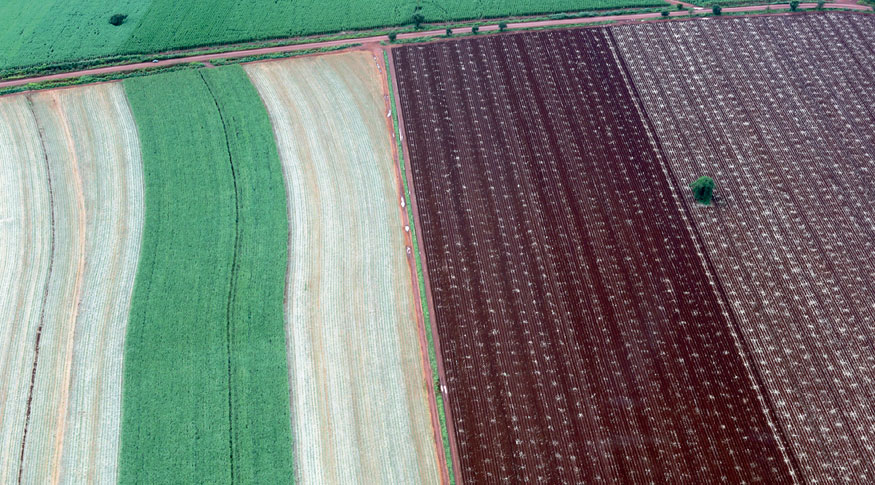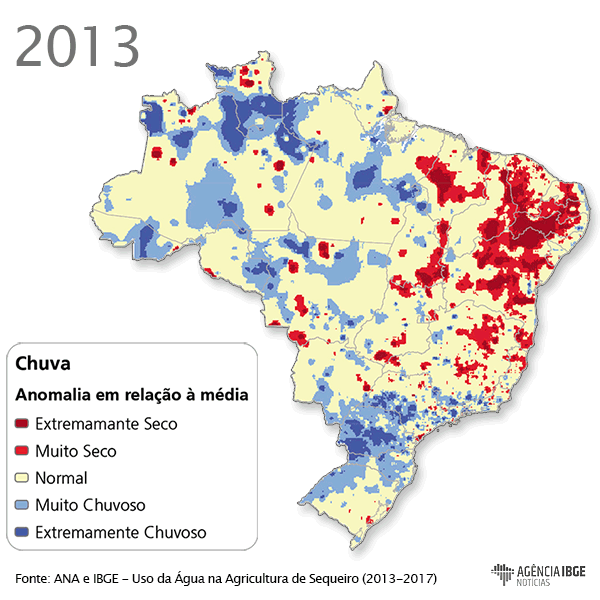Study from ANA and from the IBGE
Dependent on rainfall, dry farming has water deficit of 37%
April 14, 2020 10h00 AM | Last Updated: April 15, 2020 10h36 AM

Dry farming, which occupies more than 90% of the country's agricultural area, could be more productive, were it not for the 37% annual water deficit. This type of planting, which depends entirely on rainfall and water stored in the soil, was analyzed by the IBGE and the National Water Agency (ANA) in the survey Water Use in Dry Farming in Brazil (2013-2017).
The unprecedented study, released today (14) by the IBGE, brings strategic information for water use planning and improvement of agricultural policies and will be incorporated to the Environmental-Economic Accounting for Water. In the five analyzed years, dry farming was subject to an average water deficit of 37%, with 30% in more critical periods of vegetative growth and 7% in periods near harvesting. The deficit represents how much water lacked for the complete development of the crops.
"The Brazilian agricultural production could increase significantly with the reduction in the water deficit in dryland areas, which depends not only on abundant and scattered rainfall but also on the adequate management of soil and water in the rural properties", says Thiago Fontenelle, ANA Coordinator of Sectoral Studies.
In this respect, corn and sugarcane crops were the most affected. Whereas corn is often planted in regions and periods of increased climate risk, sugarcane was affected by a more unfavorable weather than the usual one, though this crop is more resistant to water deficit.
IBGE and ANA study estimates that the water consumed by dry farming reaches 8.1 million liters per second in the average of the analyzed years. When compared both the dry and irrigated farmings, the consumption increases to nearly 10 million liters of water per second, of which 92.5% come from rainfall and soil water and 7.5% from surface and underground additional sources. From 2013 to 2017, the changes in water use were subtle, exerting regional impacts both in terms of rainfall and as the expansion or retraction of the planted area of some crops.

"The data of the Systematic Survey of Agricultural Production (LSPA) were fundamental for those estimates", claims Carlos Alfredo Barreto Guedes, IBGE Agricultural manager. The survey estimates, om a monthly basis, the percentage of the planted areas. "From the control questions of the LSPA, we could anticipate the possibility of an study such as this one", he adds. Another important publication to support this study was the Irrigation Atlas, the biggest map of the Brazilian irrigated agriculture, produced by ANA.
Few are the countries able to measure the water consumption in dry farming. As Mr. Fontenelle puts it, "with this study, Brazil takes a leading position in the production of this indicator in the world". ANA expert highlights three points in the study presented today: the inputs that will be made available to the Environmental-Economic Accounting for Water; the calculation of the water deficit for each municipality or area, which can help map out the more vulnerable spots to weather risks and drier periods in the agricultural calendar, supporting the adoption of public policies; and the narrowing down of the relationship between ANA and the IBGE, aiming at new projects.
The study counted on the support of the German International Agency for Sustainable Development Cooperation (GIZ) and its conclusions will be useful to the National Plan of Water Resources ad the National Irrigation Plan, as well as to other government guidelines and projects of society's interest.
Environmental-Economic Accountings for Water
In March 2018, the IBGE, ANA and the Ministry of the Environment released the Environmental-Economic Accountings for Water: Brazil - 2013-2015. As a result, it was possible to understand more clearly the relationship between each economic activity and the role of water in the economic development of the country.
The initiative aims at systematically producing and disseminating information relative to the balance between the quantitative and qualitative availability of water, as well as the water demand of the several sectors of the Brazilian economy, including those of the families. The new series of the Environmental-Economic Accountings for Water: Brazil, will cover the years from 2013 to 2017 and will be put out in the beginning of May, including the regionalization of the data according to the Major Regions of Brazil.



















